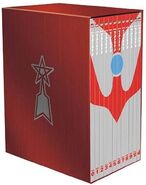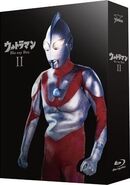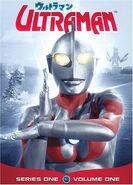(I think it's better if the episode list is combined with Ultraman series episodes page.) |
|||
| (40 intermediate revisions by 14 users not shown) | |||
| Line 1: | Line 1: | ||
| − | {{Wikipedia}} |
||
{{Series |
{{Series |
||
|Series = Ultraman (series) |
|Series = Ultraman (series) |
||
| Line 16: | Line 15: | ||
|Country Of Origin = Japan |
|Country Of Origin = Japan |
||
|Number Of Episodes = 39 |
|Number Of Episodes = 39 |
||
| − | |Running Time = |
+ | |Running Time = ~30 minutes |
|Original Channel = [[Tokyo Broadcasting System]] |
|Original Channel = [[Tokyo Broadcasting System]] |
||
|Original Air Date = July 17, 1966 |
|Original Air Date = July 17, 1966 |
||
|Preceded by = [[Ultra Q]] |
|Preceded by = [[Ultra Q]] |
||
|Succeeded by = [[Ultraseven (series)|Ultraseven]]}} |
|Succeeded by = [[Ultraseven (series)|Ultraseven]]}} |
||
| − | {{nihongo| |
+ | {{nihongo|'''Ultraman: A Special-Effects Fantasy Series'''|ウルトラマン 空想特撮シリーズ|Urutoraman: Kūsō Tokusatsu Shirīzu}}, more simply and widely known as {{nihongo|'''''Ultraman'''''|ウルトラマン|Urutoraman}}, is a Japanese [[Tokusatsu]] television series that first aired in 1966 and is a follow-up to the television series ''[[Ultra Q]]'', though not technically a sequel or spin-off. The show was produced by the [[Tsuburaya Productions]], and was broadcast on [[Tokyo Broadcasting System|Tokyo Broadcasting System (TBS)]] from July 17, 1966 to April 9, 1967, with a total of 39 episodes (40, counting the [[Birth of Ultraman|pre-premiere special]] that aired on July 10, 1966). |
| − | Although ''Ultraman'' is the first series to feature an Ultra |
+ | Although ''Ultraman'' is the first series to feature an [[:Category:Ultras|Ultra-Being]], it is actually the second show in the [[Ultra Series]]; ''[[Ultra Q]]'' was the first. In fact, ''Ultraman'' opens with the ''Ultra Q'' logo exploding into the ''Ultraman'' logo. ''Ultraman'' ultimately became a major pop culture phenomenon in Japan and then in Asia, and the rest of the world. The show's success spawned dozens of sequels, spin-offs, imitators, parodies and remakes. |
| − | |||
| − | To distinguish him from subsequent Ultra Crusaders, [[Ultraman (character)|Ultraman]] is referred to as the {{nihongo|'''Original Ultraman'''|初代ウルトラマン|Shodai Urutoraman}}, '''The First Ultraman''', or '''Ultraman Hayata'''; this last is a reference to his host's surname. |
||
This series is said to take place at some point in the 1990's; this was retconned once ''[[Return of Ultraman]]'' was released in 1971, placing the events of the series in the year of its production, 1966. |
This series is said to take place at some point in the 1990's; this was retconned once ''[[Return of Ultraman]]'' was released in 1971, placing the events of the series in the year of its production, 1966. |
||
| + | ==Synopsis== |
||
| − | ==Series Background== |
||
| ⚫ | The first series begins when [[SSSP (Science Special Search-Party)|SSSP]] member [[Shin Hayata]] is flying his plane and a red sphere of light crashes into his Sub VTOL. The sphere turns out to be the transport (Travel Sphere) for a red-and-silver giant being who calls himself [[Ultraman (character)|Ultraman]]. Feeling remorse for having killed the human, he merges his essence with Hayata to revive him. In return, Hayata serves as the human form for this being, and whenever danger threatens, and the resources of the Science Patrol are not enough to counter it, he raises and activates a device called the [[Beta Capsule]] and transforms to Ultraman to save the day. |
||
| ⚫ | |||
| ⚫ | ''Ultraman''{{'}}s central characters were created by [[Eiji Tsuburaya]] from [[Tsuburaya Productions]], a pioneer in special effects who was responsible for bringing [ |
||
| + | ==Production== |
||
| − | The Ultraman project had the following working titles/plots: |
||
| ⚫ | |||
| ⚫ | ''Ultraman''{{'}}s central characters were created by [[Eiji Tsuburaya]] from [[Tsuburaya Productions]], a pioneer in special effects who was responsible for bringing [https://wikizilla.org/wiki/Godzilla Godzilla] to life in 1954. The show's predecessor was a series called ''[[Ultra Q]]'', a black and white series with 28 episodes very much like the original ''[[Wikipedia:The Outer Limits (1963 TV series)|Outer Limits]]'', although some compare it to today's ''[[Wikipedia:The X-Files|The X-Files]]'' or ''[[Wikipedia:The Twilight Zone (1959 TV series)|The Twilight Zone]]''. |
||
| + | ===Scrapped Working Plans=== |
||
| − | *{{nihongo|''''' |
+ | *{{nihongo|'''''WoO'''''|WoO|Wū}}: This story featured a corporeal space creature with two large eyes, who befriended a reporter named Jôji Akita, but the Self Defense Forces, who perceived the alien as a threat, went after them. This was basically the monster version of the British science fiction series ''[[Wikipedia:Doctor Who|Doctor Who]]'' (1963), and Woo's personality was also to be comical. The name "Woo" ended up being used for an otherwise unrelated, [[Woo (kaiju)|yeti-like monster]], in episode 30 of ''Ultraman''. Later, Tsuburaya Productions ultimately produce a series dubbed ''[[Bio Planet WoO]],'' in January 2006, but this series is very loosely based on the original concept. |
| − | *{{nihongo|''''' |
+ | *{{nihongo|'''''Bemular'''''|ベムラー|Bemurā}}, then retitled {{nihongo|'''''Scientific Special Search-Party: Bemular'''''|科学特捜隊ベムラー|Kagaku Tokusō Tai: Bemurā}}: The main characters are a defense force, with the same Japanese name as the [[SSSP (Science Special Search-Party)|Science Patrol]], but disguised as an art/photography team. One of the members, little did anyone (even his teammates) know, gained the ability to transform into a giant birdlike humanoid monster called [[Bemular (prototype)|Bemular]] (not the same [[Bemular]] that Ultraman fight in episode 1 of the actual series), who defends Earth from monsters, aliens and other threats. Unlike Woo, Bemular was a tough and righteous fighter, and he looked very similar in design to the title monster of the 1967 kaiju film ''[[Wikipedia:Gappa: The Triphibian Monster|Gappa: The Triphibian Monster]]''. Allegedly, the plot was scrapped when it was worried audiences might have trouble telling that one monster was good and the other evil. |
| − | *{{nihongo|'''''[[Redman]]'''''|レッドマン|Reddoman}}: The title hero of this project slightly resembled Ultraman as he came to be known, but he looked more demonic and had horns. He came to Earth after his planet was destroyed by aliens from Planet X (''[[Ultraseven (series)|Ultraseven]]'' also shared this working title). |
||
| ⚫ | *{{nihongo|'''''Redman'''''|レッドマン|Reddoman}}: The title hero of this project slightly resembled Ultraman as he came to be known, but he looked more demonic and had horns. He came to Earth after his planet was destroyed by aliens from Planet X. Both Bemular and Redman were designed by [[Tohl Narita]], who also came up with the final design for Ultraman based on his Redman design, now resembling a less-scary [[Wikipedia:Buck Rogers|Buck Rogers]]-style alien being, mixed with a bit of the iconic "[[Wikipedia:Roswell UFO Incident|Roswell Alien]]." The characteristic [[Color Timer]], more familiar to American audiences as the "warning light" on Ultraman's chest, was added at the eleventh hour. ''[[Ultraseven (series)|Ultraseven]]'' also shared this working title, but it was ultimately dropped, and the title eventually became its own [[Redman (series)|series]]. |
||
| + | ===Suitmation=== |
||
| ⚫ | Both Bemular and Redman were designed by |
||
| + | [[File:Pic.jpg|thumb|left|Ultraman vs. kaiju]] |
||
| + | The Ultraman series used various monster costumes, known as ''kaiju'' in Japan, prior to other series such as ''[[w:c:kamenrider:Kamen Rider|Kamen Rider]]'' and ''[[w:c:powerrangers:Himitsu Sentai Gorenger|Himitsu Sentai Gorenger]]''. The principals were played by famous monster suit actor [[Haruo Nakajima]], who performed as the original [[Godzilla]]. Another Toho actor, Satoshi "Bin" Furuya, was sought out for the role of Ultraman, because of his tall stature and perfect proportions. Nakajima had an outdoor-sports and martial-arts background, and they decided that Ultraman would not seem alien if he was using earth-bound martial arts techniques. So Ultraman's fighting style was a mixture of grappling, Greco-Roman wrestling, and some Japanese martial arts, which evolved during the course of the series. Often costumes of famous monsters like Godzilla (as Jirass in "The Mysterious Dinosaur Base") and [[Baragon]] would be recycled and altered, sometimes with nothing more than spray paint and often while the actor was still inside. Nakajima quipped once that the staggering gait of some of the monsters he portrayed was due less to his acting than to the fumes he had to endure. Some of the quadrupedal monster costumes could not be shown fully as his legs dragging on the ground would have been exposed, a necessary allowance to maintain balance in the often cumbersome outfits. Also, the expense of repairing the scale cities and landscapes used for battle scenes required economy of movement and meticulous planning. |
||
| ⚫ | |||
| ⚫ | The first series begins when [[SSSP (Science Special Search-Party)|SSSP]] member [[Shin Hayata]] is flying his plane and a red sphere of light crashes into his |
||
| ⚫ | |||
| + | *[[Shin Hayata]] |
||
| + | *[[Toshio Muramatsu]] |
||
| + | *[[Daisuke Arashi]] |
||
| + | *[[Mitsuhiro Ide]] |
||
| + | *[[Akiko Fuji]] |
||
| + | *[[Isamu Hoshino]] |
||
| + | ===Ultras=== |
||
| − | ==Monsters and Heroes== |
||
| + | *[[Ultraman (character)|Ultraman]] |
||
| − | [[File:Ultraman_poster.png|thumb|300px|A faux Ultraman poster by Yoshikazu Yasuhiko]][[File:Pic.jpg|thumb|left|Ultraman vs. kaiju]] |
||
| + | *[[Zoffy]] |
||
| − | The Ultraman series used various monster costumes, known as ''kaiju'' in Japan, prior to other series such as ''[[w:c:kamenrider:Kamen Rider|Kamen Rider]]'' and ''[[w:c:powerrangers:Himitsu Sentai Gorenger|Himitsu Sentai Gorenger]]''. The principals were played by famous monster suit actor [[Haruo Nakajima]], who performed as the original [[Godzilla]]. Another Toho actor, Satoshi "Bin" Furuya, was sought out for the role of Ultraman, because of his tall stature and perfect proportions. |
||
| + | ===Kaiju and Seijin=== |
||
| − | Nakajima had an outdoor-sports and martial-arts background, and they decided that Ultraman would not seem alien if he was using earth-bound martial arts techniques. So Ultraman's fighting style was a mixture of grappling, Greco-Roman wrestling, and some Japanese martial arts, which evolved during the course of the series. |
||
| + | * [[Bemular]] |
||
| − | |||
| + | * [[Alien Baltan]] |
||
| − | Often costumes of famous monsters like Godzilla (as Jirass/Keyra in "The Mysterious Dinosaur Island") and [[Baragon]] would be recycled and altered, sometimes with nothing more than spray paint and often while the actor was still inside. Nakajima quipped once that the staggering gait of some of the monsters he portrayed was due less to his acting than to the fumes he had to endure. |
||
| + | * [[Neronga]] |
||
| − | |||
| + | * [[Ragon]] |
||
| − | Some of the quadrupedal monster costumes could not be shown fully as his legs dragging on the ground would have been exposed, a necessary allowance to maintain balance in the often cumbersome outfits. Also, the expense of repairing the scale cities and landscapes used for battle scenes required economy of movement and meticulous planning. |
||
| + | * [[Greenmons]] |
||
| − | |||
| + | * [[Guesra]] |
||
| − | ''For more on the monsters, go here:'' [[Ultraman (series)/Monster List|List of Ultraman monsters]] |
||
| + | * [[Antlar]] |
||
| − | |||
| + | * [[Red King]] |
||
| − | ==Story== |
||
| + | * [[Chandora]] |
||
| − | The storyline begins in the near future, as referenced from the mid-1960s (in episode 23, "[[My Home Is Earth]]", it is definitively established that the series takes place in the early 1990s, via a plaque shown at the end of the episode dated 1993) but it was later revised to take place in the 1960s. Sinister aliens and giant monsters constantly threaten civilization during this period. The only Earth organization equipped to handle these disasters is the [[SSSP (Science Special Search-Party)|Science Special Search-Party]], or SSSP, a special worldwide police force equipped with high-tech weapons and vehicles, as well as extensive scientific and engineering facilities; this organization is called the Science Patrol, or the United Nations Scientific Investigation Agency, in the English-dubbed version syndicated in the United States. |
||
| + | * [[Magular]] |
||
| − | |||
| + | * [[Suflan]] |
||
| − | The branch of the Science Patrol that is focused on in the series is located in Tokyo, Japan. Led by Captain "Cap" [[Toshio Muramatsu]] (shortened to "Captain Mura" in the dubbed English-language version), the Science Patrol is always ready to protect the Earth from rampaging monsters, but sometimes it finds itself outclassed. When the situation becomes desperate, [[Shin Hayata]], the Patrol's most capable member, holds the key to salvation in the form of a power-object and artifact called the "[[Beta Capsule]]", which, whenever activated, allows him to transform secretly into the super-humanoid-powered giant from space, who becomes known to the people of Earth as [[Ultraman (character)|Ultraman]]. |
||
| + | * [[Pigmon]] |
||
| − | |||
| + | * [[Gabora]] |
||
| − | Ultraman remains until the threat is neutralized and then flies away to revert to Hayata. (This was shown, twice, by Ultraman firing a ring of energy from his hands that would fly to a safe location, and then energy from it would materialize Hayata even as Ultraman fades away at the same time). Ultraman's victory is never assured, however, as Ultraman's powers and, indeed, his very life force, come from rapidly depleted, stored solar energy. |
||
| + | * [[Jirass]] |
||
| − | |||
| + | * [[Gango]] |
||
| − | At the beginning of each transformation from Hayata to Ultraman, the "warning light" on the giant's chest begins as a steady blue color. Yet as Ultraman exerts himself, the "[[Color Timer]]", as it is also called, turns red, then blinks, slowly at first, then with increasing rapidity as his energy reserves get closer to exhaustion. As the voice-over narration reminds the viewer, beginning with episode 2 and for each episode thereafter, if Ultraman ever reaches the point of total energy depletion, he "will never rise again". |
||
| + | * [[Mummy Man]] |
||
| − | |||
| + | * [[Dodongo]] |
||
| − | In episode 39, "[[Farewell, Ultraman]]," Ultraman fights an enemy called [[Zetton]], leader of an army of monsters bent on destroying all the Ultra Crusaders, who employs an unexpected weapon against Ultraman one which damages his Color Timer and disables his ability to measure his power supply. As a result, Ultraman stays in his full-size form too long and collapses into a dormant state. Fortunately, despite this loss, the Science Patrol's members are able to defeat Zetton on their own. |
||
| + | * [[Pestar]] |
||
| − | |||
| + | * [[Gamakujira]] |
||
| − | When [[Zoffy]], Ultraman's superior, comes to retrieve the fallen hero, Ultraman pleads for Hayata's life and offers his life completely, so that Hayata may live as a normal man. Zoffy then says he has brought two life forces and that he will give one to Hayata. He then separates them, giving Hayata new life, but Hayata seems to have no memory between the time he first collides with Ultraman's ship (in the first episode), and his standing outside Science Patrol Headquarters as he watches Zoffy take Ultraman home. This is a rather different finish to the series than stated in the English dub, which states both that Ultraman will return and that Hayata retains his Beta Capsule as he awaits Ultraman's return. |
||
| + | * [[Gavadon]] A and B |
||
| − | |||
| + | * [[Alien Baltan]] II |
||
| ⚫ | |||
| + | * [[Bullton]] |
||
| ⚫ | |||
| + | * [[Alien Zarab|Alien Zarab/Imitation Ultraman]] |
||
| − | {{Main|SSSP (Science Special Search-Party)}} |
||
| + | * [[Banila]] |
||
| − | *{{nihongo|[[Toshio Muramatsu|Captain "Cap" Toshio Muramatsu]]|ムラマツ・トシオ(村松 利夫)|Muramatsu Toshio}}: The Science Patrol's leader. He is known as Captain Mura in the US version. |
||
| + | * [[Aboras]] |
||
| − | *{{nihongo|[[Daisuke Arashi]]|アラシ・ダイスケ(嵐 大助)|Arashi Daisuke}}: The Science Patrol's rotund tough-guy marksman. |
||
| + | * [[Hydra]] |
||
| − | *{{nihongo|[[Mitsuhiro Ide]]|イデ・ミツヒロ(井出 光弘)|Ide Mitsuhiro}}: The Science Patrol's somewhat comical inventor. Although he sometimes feels that Ultraman's intervention makes his role useless, his inventions have occasionally been critical in saving the day such as helping the superhero defeat particularly formidable monsters. He is known as Ito in the US version. |
||
| + | * [[Kemular]] |
||
| − | *{{nihongo|[[Akiko Fuji]]|フジ・アキコ(富士 明子)|Fuji Akiko}}: The Science Patrol's radio/communications operator, and ostensibly their token female member. However, in most adventures, Fuji proves to be the most level-headed and capable member after Hayata. |
||
| + | * [[Underground People]] |
||
| − | *{{nihongo|[[Isamu Hoshino]]|ホシノ・イサム(星野 勇)|Hoshino Isamu}}: A little boy who is friends with the local kids. The Science Patrol's unofficial mascot, he also tends to visit the Science Patrol's headquarters to hang out with the full-fledged members. He often gets into trouble, and sometimes Ultraman has to save him. Later on, his courage during one of the Science Patrol's missions allows him to be issued a Science Patrol uniform and to go on some of their other missions. He is known as Hoshino Fuji in the US version, which describes him as Akiko Fuji's younger brother. |
||
| + | * [[Telesdon]] |
||
| − | *{{nihongo|[[Shin Hayata]]|ハヤタ・シン(早田 進)}}: The Science Patrol's brave, no-nonsense deputy captain. His life changed irreversibly when Ultraman accidentally crashed into his "Delta VTOL" with his TravelSphere and killed him, destroying both ships. To make amends, Ultraman merges his own life force into that of the Earthman before the brain functions of the latter are irreversibly terminated, thus reviving him. He then gives Hayata the power-object called the beta capsule, a microphone shaped cylinder device, with which he can transform into Ultraman by depressing a red push-button switch on its side with his thumb to activate it. |
||
| + | * [[Jamila]] |
||
| + | * [[Gubila]] |
||
| + | * [[Gigass]] |
||
| + | * [[Dorako]] |
||
| + | * [[Red King|Red King]] II |
||
| + | * [[Gomora]] |
||
| + | * [[Dada]] |
||
| + | * [[Goldon]] |
||
| + | * [[Woo (kaiju)|Woo]] |
||
| + | * [[Keronia]] |
||
| + | * [[Zambolar]] |
||
| + | * [[Akiko Fuji|Giant Fuji]] |
||
| + | * [[Alien Baltan]] III |
||
| + | * [[Kemur Man]] II |
||
| + | * [[Alien Zarab]] II |
||
| + | * [[Alien Mefilas]] |
||
| + | * [[Skydon]] |
||
| + | * [[Seabozu]] |
||
| + | * [[Zaragas]] |
||
| + | * [[Geronimon]] |
||
| + | * [[Kiyla]] |
||
| + | * [[Saigo]] |
||
| + | * [[Alien Zetton]] |
||
| + | * [[Zetton]] |
||
==Cast== |
==Cast== |
||
| Line 83: | Line 115: | ||
*{{nihongo|[[Akiko Fuji]]|フジ アキコ|Fuji Akiko}}: {{Nihongo|[[Hiroko Sakurai]]|櫻井 浩子|Sakurai Hiroko}} |
*{{nihongo|[[Akiko Fuji]]|フジ アキコ|Fuji Akiko}}: {{Nihongo|[[Hiroko Sakurai]]|櫻井 浩子|Sakurai Hiroko}} |
||
*{{nihongo|[[Daisuke Arashi]]|アラシ・ダイスケ|Arashi Daisuke}}: {{nihongo|[[Sandayū Dokumamushi]]|毒蝮 三太夫|Dokumamushi Sandayū}} |
*{{nihongo|[[Daisuke Arashi]]|アラシ・ダイスケ|Arashi Daisuke}}: {{nihongo|[[Sandayū Dokumamushi]]|毒蝮 三太夫|Dokumamushi Sandayū}} |
||
| − | *{{nihongo|[[Mitsuhiro Ide]]|イデ・ミツヒロ|Ide Mitsuhiro}}: {{nihongo|[[Masanari Nihei]]|二 |
+ | *{{nihongo|[[Mitsuhiro Ide]]|イデ・ミツヒロ|Ide Mitsuhiro}}: {{nihongo|[[Masanari Nihei]]|二瓶 正也|Nihei Masanari}} |
*{{nihongo|[[Isamu Hoshino]]|ホシノ・イサム|Hoshino Isamu}}: {{nihongo|[[Akihide Tsuwaza]]|津沢 彰秀|Tsuzawa Akihide}} |
*{{nihongo|[[Isamu Hoshino]]|ホシノ・イサム|Hoshino Isamu}}: {{nihongo|[[Akihide Tsuwaza]]|津沢 彰秀|Tsuzawa Akihide}} |
||
| − | *{{nihongo|Narrator|ナレーター| |
+ | *{{nihongo|Narrator|ナレーター|Narētā}}: {{nihongo|[[Koji Ishizaka]]|石坂浩二|Ishizaka Koji}} (1-19), {{nihongo|[[Hikari Urano]]|浦野光|Urano Hikari}} (20-39) |
| + | |||
| + | ===English Dub=== |
||
| + | *Peter Fernandez |
||
| + | *Corrine Orr |
||
| + | *Earl Hammond |
||
==Theme Song== |
==Theme Song== |
||
| Line 92: | Line 129: | ||
**Composition: [[Kunio Miyauchi]] |
**Composition: [[Kunio Miyauchi]] |
||
**Artist: [[Misuzu Children's Choral Group]] |
**Artist: [[Misuzu Children's Choral Group]] |
||
| + | |||
| ⚫ | |||
| ⚫ | Malaysia has banned an Ultraman comic book because it uses the word "Allah" to describe the Japanese action hero. The Home Ministry said in a statement Friday (7/3/2014) that the Malay-edition of "Ultraman, The Ultra Power" contained elements that can undermine public security and societal morals. It said "Ultraman is idolized by many children" and equating the lead character, [[Ultraman King]], with Allah would especially "confuse Muslim children and damage their faith". Allah, the Arabic word for God, is commonly used in the Malay language to refer to God. The government says Allah should be exclusively reserved for Muslims because of concerns its use by others would confuse Muslims and tempt them to convert. Malay Muslims account for about 60 percent of Malaysia's 30 million people, while Christians makeup about 9 percent of the country's population. The ministry said Allah is holy for Muslims and warned that such irresponsible use of the word can provoke the community and threaten public safety. Ultraman is a fictional Japanese superhero who fights monsters and first appeared on television in the 1960s. A line in the book said Ultraman "is considered and respected as Allah, or the Elder, to all Ultra heroes". "The Ultraman character itself is not banned and only this edition is prohibited", the ministry said. Anyone caught distributing the book could be jailed three years, it warned. The government's stand over the word Allah has sparked a controversy in this multi-racial Southeast Asian country, where many Malay-speaking Christians commonly use Allah to refer to God. Religious tensions have been high in the past five years after the Catholic church went to court to seek the right to use Allah in its weekly newspaper. A lower court last year ruled in favor of the government, which the Catholic church has appealed to the country's highest court. The Federal Court said Wednesday it will decide at a later date whether to hear the case. The [[Ultra Series]] however is very popular in Malaysia. |
||
==Home Media== |
==Home Media== |
||
| − | In 2006, BCI/Eclipse officially released Ultraman on DVD under license from then rightsholder Chaiyo Productions. These releases featured the original Japanese soundtrack and the English dub. When Navarre folded BCI/Eclipse in December 2008, the series was shuffled over to Navarre's other home video label, Mill Creek Entertainment. In June 2009, Mill Creek re-released the complete series set on September 29, 2009, in a 4-disc set with the same special features |
+ | In 2006, BCI/Eclipse officially released Ultraman on DVD under license from then rightsholder Chaiyo Productions. These releases featured the original Japanese soundtrack and the English dub. When Navarre folded BCI/Eclipse in December 2008, the series was shuffled over to Navarre's other home video label, Mill Creek Entertainment. In June 2009, Mill Creek re-released the complete series set on September 29, 2009, in a 4-disc set with the same special features. |
| − | On April 2013, Tsuburaya held a press conference announcing the new [[Ultra Series]] show and character, [[Ultraman Ginga (character)|Ultraman Ginga]], where they also announced that the original 1966 show will be given an HD remaster treatment in Japan |
+ | In Japan, there have been numerous releases in numerous home video formats over the last 25 years (from VHS to DVD) on several labels, including Bandai's various home video divisions, including Bandai Visual. On April 2013, Tsuburaya held a press conference announcing the new [[Ultra Series]] show and character, [[Ultraman Ginga (character)|Ultraman Ginga]], where they also announced that the original 1966 show will be given an HD remaster treatment in Japan. |
| + | |||
| + | On July 2013, Tsuburaya released an HD transfer of Ultraman on Blu-ray titled Ultraman HD Remaster 2.0, to commemorate the 50th anniversary of Tsuburaya Productions. Tsuburaya plans to release the series on three separate box sets, each containing 13 episodes. The first box set was released on July 10, 2013, the second on October 25, 2013 and the final set is planned for January 29, 2014. |
||
A Malaysian DVD Boxset was released by VGB Network in 2013, containing Malaysian subtitles and English subtitles. |
A Malaysian DVD Boxset was released by VGB Network in 2013, containing Malaysian subtitles and English subtitles. |
||
| ⚫ | |||
| + | Mill Creek Entertainment also released the series under Blu-Ray and Steelbook editions in 2019, along with ''Ultra Q''. |
||
| − | ==Adaptations== |
||
| − | Harvey Comics Entertainment published two short comic book series based on Ultraman in 1993 and 1994. |
||
| − | |||
| − | Bandai published the video game ''[[PD Ultraman Battle Collection 64]]'' for the Nintendo 64 in 1997. |
||
| − | |||
| − | On November 2013, a source close to Chaiyo Productions told the website [http://nukethefridge.com/2013/11/17/ultraman-movie-will-smith/ Nuke the Fridge] that an English-language feature film is in development for a targeted 2016 release. The studio plans to approach several A-list actors for the lead role, including [[Wikipedia:Will Smith|Will Smith]], and plan to produce the film in a style similar to [[Wikipedia:Pacific Rim (film)|Pacific Rim]]. |
||
| − | |||
| ⚫ | |||
| ⚫ | Malaysia has banned an Ultraman comic book because it uses the word "Allah" to describe the Japanese action hero. The Home Ministry said in a statement Friday (7/3/2014) that the Malay-edition of "Ultraman, The Ultra Power" contained elements that can undermine public security and societal morals. It said "Ultraman is idolized by many children" and equating the lead character, [[Ultraman King]], with Allah would especially "confuse Muslim children and damage their faith". Allah, the Arabic word for God, is commonly used in the Malay language to refer to God. The government says Allah should be exclusively reserved for Muslims because of concerns its use by others would confuse Muslims and tempt them to convert. Malay Muslims account for about 60 percent of Malaysia's 30 million people, while Christians makeup about 9 percent of the country's population. |
||
| − | |||
| − | The ministry said Allah is holy for Muslims and warned that such irresponsible use of the word can provoke the community and threaten public safety. Ultraman is a fictional Japanese superhero who fights monsters and first appeared on television in the 1960s. A line in the book said Ultraman "is considered and respected as Allah, or the Elder, to all Ultra heroes". "The Ultraman character itself is not banned and only this edition is prohibited", the ministry said. Anyone caught distributing the book could be jailed three years, it warned. The government's stand over the word Allah has sparked a controversy in this multi-racial Southeast Asian country, where many Malay-speaking Christians commonly use Allah to refer to God. |
||
| − | |||
| − | Religious tensions have been high in the past five years after the Catholic church went to court to seek the right to use Allah in its weekly newspaper. A lower court last year ruled in favor of the government, which the Catholic church has appealed to the country's highest court. The Federal Court said Wednesday it will decide at a later date whether to hear the case. |
||
| − | |||
| − | The [[Ultra Series]] however is very popular in Malaysia. |
||
| − | |||
| − | ==DVD/Blu-Ray Sets Release== |
||
| ⚫ | |||
<gallery> |
<gallery> |
||
| ⚫ | |||
Ultraman_MB_DVD.jpg|Ultraman Memorial Box |
Ultraman_MB_DVD.jpg|Ultraman Memorial Box |
||
41WfbiRdNUL.jpg|Ultraman Blu-Ray Box I |
41WfbiRdNUL.jpg|Ultraman Blu-Ray Box I |
||
042.jpg|Ultraman Blu-Ray Box II |
042.jpg|Ultraman Blu-Ray Box II |
||
9390000058275.jpg|Ultraman Blu-Ray Box III |
9390000058275.jpg|Ultraman Blu-Ray Box III |
||
| + | 63425_3l.png|Blu-ray release of Ultraman by Mill Creek |
||
| ⚫ | |||
UltramanBCI_vol.1.jpg|Ultraman BCI/Eclipse Vol. 1 |
UltramanBCI_vol.1.jpg|Ultraman BCI/Eclipse Vol. 1 |
||
UltramanBCI_vol2.jpg|Ultraman BCI/Eclipse Vol. 2 |
UltramanBCI_vol2.jpg|Ultraman BCI/Eclipse Vol. 2 |
||
| Line 129: | Line 156: | ||
UltramanMalayVGBBack.jpg|Ultraman VGB Network Back |
UltramanMalayVGBBack.jpg|Ultraman VGB Network Back |
||
</gallery> |
</gallery> |
||
| − | |||
| − | ==References== |
||
| − | *[https://en.wikipedia.org/wiki/Ultraman ''Ultraman'' at Wikipedia] |
||
{{Shows and Films}} |
{{Shows and Films}} |
||
| − | |||
[[id:Ultraman (seri)]] |
[[id:Ultraman (seri)]] |
||
[[ja:ウルトラマン]] |
[[ja:ウルトラマン]] |
||
Revision as of 22:18, 11 September 2019
Ultraman: A Special-Effects Fantasy Series , more simply and widely known as Ultraman , is a Japanese Tokusatsu television series that first aired in 1966 and is a follow-up to the television series Ultra Q, though not technically a sequel or spin-off. The show was produced by the Tsuburaya Productions, and was broadcast on Tokyo Broadcasting System (TBS) from July 17, 1966 to April 9, 1967, with a total of 39 episodes (40, counting the pre-premiere special that aired on July 10, 1966).
Although Ultraman is the first series to feature an Ultra-Being, it is actually the second show in the Ultra Series; Ultra Q was the first. In fact, Ultraman opens with the Ultra Q logo exploding into the Ultraman logo. Ultraman ultimately became a major pop culture phenomenon in Japan and then in Asia, and the rest of the world. The show's success spawned dozens of sequels, spin-offs, imitators, parodies and remakes.
This series is said to take place at some point in the 1990's; this was retconned once Return of Ultraman was released in 1971, placing the events of the series in the year of its production, 1966.
Synopsis
The first series begins when SSSP member Shin Hayata is flying his plane and a red sphere of light crashes into his Sub VTOL. The sphere turns out to be the transport (Travel Sphere) for a red-and-silver giant being who calls himself Ultraman. Feeling remorse for having killed the human, he merges his essence with Hayata to revive him. In return, Hayata serves as the human form for this being, and whenever danger threatens, and the resources of the Science Patrol are not enough to counter it, he raises and activates a device called the Beta Capsule and transforms to Ultraman to save the day.
Production
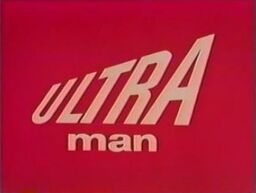
The English title card
Ultraman's central characters were created by Eiji Tsuburaya from Tsuburaya Productions, a pioneer in special effects who was responsible for bringing Godzilla to life in 1954. The show's predecessor was a series called Ultra Q, a black and white series with 28 episodes very much like the original Outer Limits, although some compare it to today's The X-Files or The Twilight Zone.
Scrapped Working Plans
- WoO : This story featured a corporeal space creature with two large eyes, who befriended a reporter named Jôji Akita, but the Self Defense Forces, who perceived the alien as a threat, went after them. This was basically the monster version of the British science fiction series Doctor Who (1963), and Woo's personality was also to be comical. The name "Woo" ended up being used for an otherwise unrelated, yeti-like monster, in episode 30 of Ultraman. Later, Tsuburaya Productions ultimately produce a series dubbed Bio Planet WoO, in January 2006, but this series is very loosely based on the original concept.
- Bemular , then retitled Scientific Special Search-Party: Bemular : The main characters are a defense force, with the same Japanese name as the Science Patrol, but disguised as an art/photography team. One of the members, little did anyone (even his teammates) know, gained the ability to transform into a giant birdlike humanoid monster called Bemular (not the same Bemular that Ultraman fight in episode 1 of the actual series), who defends Earth from monsters, aliens and other threats. Unlike Woo, Bemular was a tough and righteous fighter, and he looked very similar in design to the title monster of the 1967 kaiju film Gappa: The Triphibian Monster. Allegedly, the plot was scrapped when it was worried audiences might have trouble telling that one monster was good and the other evil.
- Redman : The title hero of this project slightly resembled Ultraman as he came to be known, but he looked more demonic and had horns. He came to Earth after his planet was destroyed by aliens from Planet X. Both Bemular and Redman were designed by Tohl Narita, who also came up with the final design for Ultraman based on his Redman design, now resembling a less-scary Buck Rogers-style alien being, mixed with a bit of the iconic "Roswell Alien." The characteristic Color Timer, more familiar to American audiences as the "warning light" on Ultraman's chest, was added at the eleventh hour. Ultraseven also shared this working title, but it was ultimately dropped, and the title eventually became its own series.
Suitmation
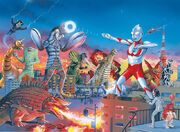
Ultraman vs. kaiju
The Ultraman series used various monster costumes, known as kaiju in Japan, prior to other series such as Kamen Rider and Himitsu Sentai Gorenger. The principals were played by famous monster suit actor Haruo Nakajima, who performed as the original Godzilla. Another Toho actor, Satoshi "Bin" Furuya, was sought out for the role of Ultraman, because of his tall stature and perfect proportions. Nakajima had an outdoor-sports and martial-arts background, and they decided that Ultraman would not seem alien if he was using earth-bound martial arts techniques. So Ultraman's fighting style was a mixture of grappling, Greco-Roman wrestling, and some Japanese martial arts, which evolved during the course of the series. Often costumes of famous monsters like Godzilla (as Jirass in "The Mysterious Dinosaur Base") and Baragon would be recycled and altered, sometimes with nothing more than spray paint and often while the actor was still inside. Nakajima quipped once that the staggering gait of some of the monsters he portrayed was due less to his acting than to the fumes he had to endure. Some of the quadrupedal monster costumes could not be shown fully as his legs dragging on the ground would have been exposed, a necessary allowance to maintain balance in the often cumbersome outfits. Also, the expense of repairing the scale cities and landscapes used for battle scenes required economy of movement and meticulous planning.
Characters
SSSP/United Nations Scientific Investigation Agency
Ultras
Kaiju and Seijin
- Bemular
- Alien Baltan
- Neronga
- Ragon
- Greenmons
- Guesra
- Antlar
- Red King
- Chandora
- Magular
- Suflan
- Pigmon
- Gabora
- Jirass
- Gango
- Mummy Man
- Dodongo
- Pestar
- Gamakujira
- Gavadon A and B
- Alien Baltan II
- Bullton
- Alien Zarab/Imitation Ultraman
- Banila
- Aboras
- Hydra
- Kemular
- Underground People
- Telesdon
- Jamila
- Gubila
- Gigass
- Dorako
- Red King II
- Gomora
- Dada
- Goldon
- Woo
- Keronia
- Zambolar
- Giant Fuji
- Alien Baltan III
- Kemur Man II
- Alien Zarab II
- Alien Mefilas
- Skydon
- Seabozu
- Zaragas
- Geronimon
- Kiyla
- Saigo
- Alien Zetton
- Zetton
Cast
- Shin Hayata : Susumu Kurobe
- Toshio Muramatsu : Akiji Kobayashi
- Akiko Fuji : Hiroko Sakurai
- Daisuke Arashi : Sandayū Dokumamushi
- Mitsuhiro Ide : Masanari Nihei
- Isamu Hoshino : Akihide Tsuwaza
- Narrator : Koji Ishizaka (1-19), Hikari Urano (20-39)
English Dub
- Peter Fernandez
- Corrine Orr
- Earl Hammond
Theme Song
- "Ultraman no Uta"
- Lyrics: Kyoichi Azuma
- Composition: Kunio Miyauchi
- Artist: Misuzu Children's Choral Group
Malaysia Book Ban
Malaysia has banned an Ultraman comic book because it uses the word "Allah" to describe the Japanese action hero. The Home Ministry said in a statement Friday (7/3/2014) that the Malay-edition of "Ultraman, The Ultra Power" contained elements that can undermine public security and societal morals. It said "Ultraman is idolized by many children" and equating the lead character, Ultraman King, with Allah would especially "confuse Muslim children and damage their faith". Allah, the Arabic word for God, is commonly used in the Malay language to refer to God. The government says Allah should be exclusively reserved for Muslims because of concerns its use by others would confuse Muslims and tempt them to convert. Malay Muslims account for about 60 percent of Malaysia's 30 million people, while Christians makeup about 9 percent of the country's population. The ministry said Allah is holy for Muslims and warned that such irresponsible use of the word can provoke the community and threaten public safety. Ultraman is a fictional Japanese superhero who fights monsters and first appeared on television in the 1960s. A line in the book said Ultraman "is considered and respected as Allah, or the Elder, to all Ultra heroes". "The Ultraman character itself is not banned and only this edition is prohibited", the ministry said. Anyone caught distributing the book could be jailed three years, it warned. The government's stand over the word Allah has sparked a controversy in this multi-racial Southeast Asian country, where many Malay-speaking Christians commonly use Allah to refer to God. Religious tensions have been high in the past five years after the Catholic church went to court to seek the right to use Allah in its weekly newspaper. A lower court last year ruled in favor of the government, which the Catholic church has appealed to the country's highest court. The Federal Court said Wednesday it will decide at a later date whether to hear the case. The Ultra Series however is very popular in Malaysia.
Home Media
In 2006, BCI/Eclipse officially released Ultraman on DVD under license from then rightsholder Chaiyo Productions. These releases featured the original Japanese soundtrack and the English dub. When Navarre folded BCI/Eclipse in December 2008, the series was shuffled over to Navarre's other home video label, Mill Creek Entertainment. In June 2009, Mill Creek re-released the complete series set on September 29, 2009, in a 4-disc set with the same special features.
In Japan, there have been numerous releases in numerous home video formats over the last 25 years (from VHS to DVD) on several labels, including Bandai's various home video divisions, including Bandai Visual. On April 2013, Tsuburaya held a press conference announcing the new Ultra Series show and character, Ultraman Ginga, where they also announced that the original 1966 show will be given an HD remaster treatment in Japan.
On July 2013, Tsuburaya released an HD transfer of Ultraman on Blu-ray titled Ultraman HD Remaster 2.0, to commemorate the 50th anniversary of Tsuburaya Productions. Tsuburaya plans to release the series on three separate box sets, each containing 13 episodes. The first box set was released on July 10, 2013, the second on October 25, 2013 and the final set is planned for January 29, 2014.
A Malaysian DVD Boxset was released by VGB Network in 2013, containing Malaysian subtitles and English subtitles. Ultraman Memorial Box features 4 episodes in each DVD, and the last features 3 episodes. Ultraman Blu-Ray Box I features episodes 1-13, Box II features episodes 14-26, and Box III features episodes 27-29.
Mill Creek Entertainment also released the series under Blu-Ray and Steelbook editions in 2019, along with Ultra Q.
Template:Shows and Films

